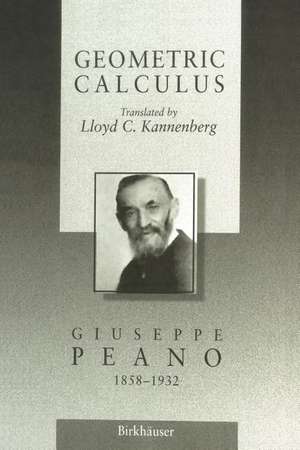Geometric Calculus: According to the Ausdehnungslehre of H. Grassmann
Autor Giuseppe Peano Traducere de L.C. Kannenbergen Limba Engleză Paperback – 21 sep 2011
Preț: 381.00 lei
Nou
Puncte Express: 572
Preț estimativ în valută:
72.91€ • 76.31$ • 60.68£
72.91€ • 76.31$ • 60.68£
Carte tipărită la comandă
Livrare economică 31 martie-14 aprilie
Preluare comenzi: 021 569.72.76
Specificații
ISBN-13: 9781461274278
ISBN-10: 1461274273
Pagini: 172
Ilustrații: XV, 150 p.
Dimensiuni: 155 x 235 x 9 mm
Greutate: 0.25 kg
Ediția:Softcover reprint of the original 1st ed. 2000
Editura: Birkhäuser Boston
Colecția Birkhäuser
Locul publicării:Boston, MA, United States
ISBN-10: 1461274273
Pagini: 172
Ilustrații: XV, 150 p.
Dimensiuni: 155 x 235 x 9 mm
Greutate: 0.25 kg
Ediția:Softcover reprint of the original 1st ed. 2000
Editura: Birkhäuser Boston
Colecția Birkhäuser
Locul publicării:Boston, MA, United States
Public țintă
ResearchCuprins
The Operations of Deductive Logic.- I Geometric Formations.- II Formations of the First Species.- III Formations of the Second Species.- IV Formations of the Third Species.- V Formations on a Right-Line.- VI Formations in the Plane.- VII Formations in Space.- VIII Derivatives.- IX Transformations of Linear Systems.- Editorial notes.
Recenzii
"Giuseppe Peano (1858-1932) who distinguished himself in several branches of mathematics, was among the earliest ones to duly appreciate Grassmann's algebraic ideas."
--Zentralblatt Math.
--Zentralblatt Math.
Textul de pe ultima copertă
Calcolo Geometrico, G. Peano's first publication in mathematical logic, is a model of expository writing, with a significant impact on 20th century mathematics. Kannenberg's lucid and crisp translation, Geometric Calculus, will appeal to historians of mathematics, researchers, graduate students, and general readers interested in the foundations of mathematics and the development of a formal logical language.
In Chapter IX, with the innocent-sounding title "Transformations of a linear system," one finds the crown jewel of the book: Peano's axiom system for a vector space, the first-ever presentation of a set of such axioms. The very wording of the axioms (which Peano calls "definitions") has a remarkably modern ring, almost like a modern introduction to linear algebra. Peano also presents the basic calculus of set operation, introducing the notation for 'intersection,' 'union,' and 'element of,' many years before it was accepted.
Despite its uniqueness, Calcolo Geometrico has been strangely neglected by historians of mathematics, and even by scholars of Peano. The book has never been reprinted in its entirety, and only two chapters have ever been translated into English. In part, this neglect has been due to Peano's organization of the work. That is, the section on mathematical logic bears almost no relation to the rest of the book, and the material there was superseded only a year after its publication by Peano's second book. Since all but this first section was generally thought to be expository rather than original work, it was regarded lightly, if noticed at all, and ultimately all but forgotten. Only in very recent years have the book's unique merits begun to be recognized.
Among these merits are Peano’s presentation of the essential features of Grassmann’s notoriously obscure Ausdehnungslehre, a clarification and improvement upon Grassmann’s theory of extensive magnitudes, and a disseminationof other hard-to-understand material.
Readers of this valuable translation will gain insight into the work of a distinguished mathematician and founder of mathematical logic.
In Chapter IX, with the innocent-sounding title "Transformations of a linear system," one finds the crown jewel of the book: Peano's axiom system for a vector space, the first-ever presentation of a set of such axioms. The very wording of the axioms (which Peano calls "definitions") has a remarkably modern ring, almost like a modern introduction to linear algebra. Peano also presents the basic calculus of set operation, introducing the notation for 'intersection,' 'union,' and 'element of,' many years before it was accepted.
Despite its uniqueness, Calcolo Geometrico has been strangely neglected by historians of mathematics, and even by scholars of Peano. The book has never been reprinted in its entirety, and only two chapters have ever been translated into English. In part, this neglect has been due to Peano's organization of the work. That is, the section on mathematical logic bears almost no relation to the rest of the book, and the material there was superseded only a year after its publication by Peano's second book. Since all but this first section was generally thought to be expository rather than original work, it was regarded lightly, if noticed at all, and ultimately all but forgotten. Only in very recent years have the book's unique merits begun to be recognized.
Among these merits are Peano’s presentation of the essential features of Grassmann’s notoriously obscure Ausdehnungslehre, a clarification and improvement upon Grassmann’s theory of extensive magnitudes, and a disseminationof other hard-to-understand material.
Readers of this valuable translation will gain insight into the work of a distinguished mathematician and founder of mathematical logic.
















